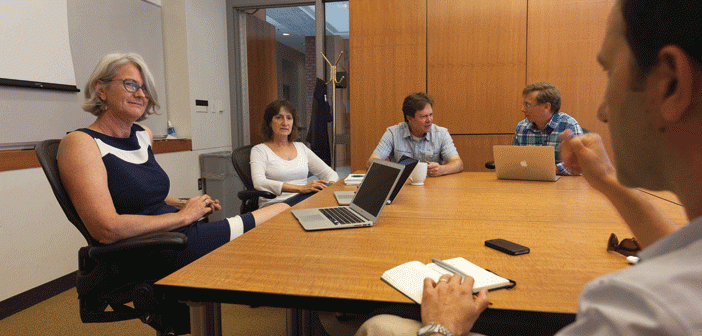A new grant supports collaboration in migraine research.
Migraines have no cure, a daunting fact for the estimated 28 million Americans who suffer from this debilitating chronic disease. It’s even more daunting for researchers who are still struggling to understand the basics of migraine— its causes, its triggers, even how it works.
“We have all seen friends and family members crippled by the unrelenting pain of migraine,” says Diane Lipscombe, PhD, professor of neuroscience. “But our current lack of knowledge of the basic mechanisms underlying this type of pain limits new therapeutic strategies for treatment.”
Thanks to a grant from the Association for Migraine Disorders, Lipscombe, the interim director of the Brown Institute for Brain Science, is partnering with three BIBS colleagues, all of whom study the physiology of pain, to investigate the cells and circuits that cause migraine as well as opportunities for creating therapies.
The $100,000, multi-investigator pilot grant will also support Julie Kauer, PhD, professor of medical science and neuroscience; Christopher Moore, PhD, associate professor of neuroscience; and Carl Saab, PhD, assistant professor of neurosurgery and neuroscience. Their research also may involve the development of a mouse model to better understand the physiology behind migraine. In addition the association, which is based in North Kingstown, RI, committed $200,000 for a postdoctoral fellow.
BIBS unites researchers across disciplines to study brain function and health, and diverse working groups such as this—with investigators who will examine migraine at the behavioral, circuit, cellular, and molecular levels—reflect the institute’s core mission, says Lipscombe: “to facilitate collaborative research aimed at understanding basic and disease mechanisms of the brain.”
The grant integrates several efforts at Brown into one cohesive project, breaking down the barriers that often inhibit research and discovery. “Individually, a number of labs at Brown are working on pieces of the migraine puzzle from different perspectives,” Moore says. “This new partnership with the Association of Migraine Disorders is letting us bring these together in a coherent attack on the problem—one that leverages these distinct areas of expertise. It’s a great opportunity to make a real impact across multiple levels.”
Frederick Godley, MD, president of the association, says he hopes the grant is just the beginning of a long-term collaboration with Brown researchers. “Our goal is to help migraineurs everywhere gain more attention for their chronic disease,” Godley says. “We see the partnership with the Brown Institute for Brain Science as a unique part of our organization’s plan to lead the effort to understand and cure migraine disease.”




